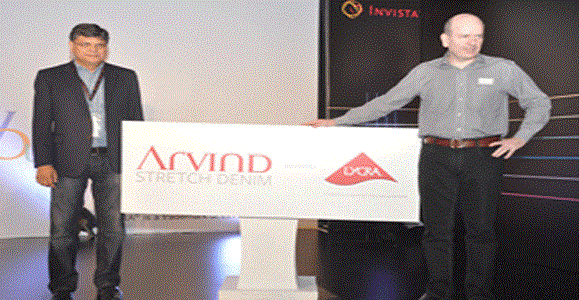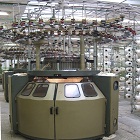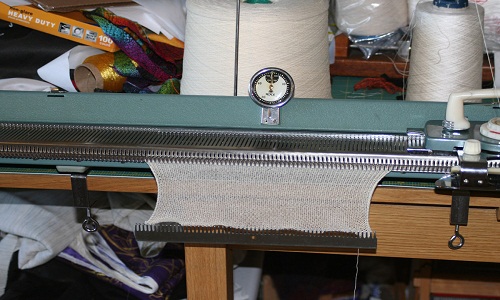FW

With growing emphasis on innovation, sustainability and fashion design worldwide, Arvind Mills, India’s top composite textiles player, tied up with globally acclaimed technology giant INVISTA. And Aamir Akhtar, CEO, Arvind Mills is optimistic their partnership will lead to bigger things as he says, “We have seen the partnership with INVISTA grow. Together, we will be unfolding a lot of things.”
A power house partnership

Endorsing Akhtar’s views, Huw Williams, Global Marketing Director, INVISTA, observes, “One of the most important things about strategic tie-ups is the culture fit. If you are working for a company that’s culturally aligned with you, this is a fine collaboration. We are trying to put premium products in the market. We have a common strategy and a common culture. Arvind has a huge industrial capability. They can make things efficiently as they have design capability, fabric innovation capability and can sell very effectively in a fragmented market. Our capability is fibre and fabric innovation. If you bring these two sets of capabilities together you create a win-win combination. Working with Arvind in western markets we have had great success with western brands and retailers.”
Innovative denim in the limelight
Giving an insight on Arvind’s innovative offerings Akhtar explains, “Arvind’s share in the value added segment is 55 per cent. We have launched a new technology. This is a new way of dyeing denim on the surface. It is not printing but indigo dyeing. With this, we can create deep dark indigos. Using this technology, we can come out with a whole range of knit denims, which has a strong demand now. Then there is ‘Neo Bubble’, which is lightweight denim for women’s wear, tops and ethnic wear. We have new dyed corduroys with stretch in different colours.” Throwing more light on ‘Arvind Stretch Denim powered by Lycra HangTag’ concept, Akhtar said, “Earlier, the fabric used to be sent out to different places through a complex supply chain and was difficult to tag. Now, ‘Arvind Lycra’ tag will go along with the fabric. The end user of the fabric, the cutter, the garment maker can convert it into garments when the tag is there. Once he sees the value in this brand, and its strong value proposition, as a promise, he would like to use the tags. The tag Arvind Lycra is also for B2C promotions.” Williams further explained the idea “The Arvind Lycra hang tag is an example of our collaboration. We are using Arvind’s distribution channels in India. The hang tag will be rolled out through their distribution channels in an easy to access way. We hope to see these hang tags appear on high quality garments.” The tie-up of these global brands in India is looked up to as a new era of innovation in textile industry. With the high profile tie-up between Arvind Mills and INVISTA, Indian textile industry has got a new dimension to face challenges in global as well as domestic markets.
The second edition of Texworld Istanbul is being held April 7 and 8. This is a purchasing point for fashion fabrics. It brings together the most relevant apparel textile suppliers and buyers in the midst of a booming region. It’s the prime opportunity for fabric manufacturers to connect with the top buyers in the region and beyond.
Nearly 150 exhibiting companies from the Euro-Mediterranean region and Asia are taking part. Among these are companies from China, Hong Kong, South Korea, Taiwan, Indonesia, India and Pakistan as well as Egypt, Germany and Turkey.Products such as cotton, embroidery and lace, knitted fabrics, wool and wool blends, functional fabrics, linens, prints, fibers, yarns and denims will be showcased.
The first Texworld Istanbul was held in November 2014. It welcomed 115 exhibitors from 10 countries, attracting 5,248 professional visitors, with 25 per cent from abroad. Turkey is today one of the most important places for the international textile industry. It is located at the crossroads of south eastern Europe, the Middle East, Central Asia and North Africa. Most international fashion fabric manufacturers have not yet sufficiently explored the manufacturing industries in those four regions. Texworld Istanbul aims at assembling players from those unexplored regions under one roof, at one fair.
https://texworld-istanbul.tr.messefrankfurt.com/
The California Classic Alpaca and Fiber Show will be held on April 11 and 12. A number of alpaca breeders from ranches in California, Nevada, Oregon and Arizona will be represented at the event. The show will feature some 200 alpacas. Visitors will get to touch and feel the alpaca’s soft fiber.
Visitors can learn more about the alpaca industry and meet alpaca breeders. Fiber enthusiast and artisans will showcase alpaca fiber (raw fiber, roving, and yarn) and examples of felting and fiber arts. Vendors will display alpaca fashions and hand-crafted items plus ongoing fiber demonstrations.
The alpaca is often compared to the softness of cashmere. It’s hypoallergenic, one-third the weight of wool, and is comfortably smooth against skin. The fiber comes from an animal that is manageable and hums to communicate. Alpacas require small acreage and are considered green livestock.
The highly prized fleece has inspired many to start cottage industries which involve shearing alpacas and spinning the fiber into yarn that can be made into high quality apparel while others market the fiber through the support of organized fiber co-ops. Alpaca breeders from all walks of life interact with each other by participating in shows and open houses, co-owning animals, and by sharing their acquired expertise.
Kitex Garments has recorded a net profit of Rs 99 crores for the financial year ended March 31, 2015, an increase of 73 per cent from the profit of Rs 57 crores the company made during 2013-14. The total revenue of the company in financial year 2014-15 was Rs 525 crores. It was only Rs 456 crores during the same period last year. This indicates a growth of 15 per cent. Profit before interest depreciation and taxes registered a growth of 69 per cent.
Share price rose six times, from Rs 89 on March 31, 2014, to Rs 534 as on March 31, 2015. The earnings per equity share of Rs 1 during 2014-15 were Rs 20.74 against Rs 12.08 in 2013-14. Kitex Garments is the first among listed companies to publish audited financial results in the country consistently for the third year in a row. It has achieved these levels of performance by technology upgradation and high level of productivity in operations.
Kitex is the third largest manufacturing facility in the infant wear segment globally and the company aspires to become the global number one by 2018.
www.kitexgarments.com/
Winners of SDC EC’s 5th National Students Competition 2015- Young Talent Search were announced recently. Mumbai Chapter, SDC EC had organised the competition on March 27, 2015 at The Textiles Committee, Mumbai. The theme for this year’s competition was ‘Innovations in colour and its use’. The contest received over 25 entries for colouration and fashion categories.
Six entries from colouration and five entries from fashion were shortlisted. The winners were declared from both categories separately. Under the colouration session, a project tilted ‘Novel effects by effective combinations’ by Priyanka Shinde and Swapnali Patil of Institute of Chemical Technology (ICT) was declared the winning entry. Prashant Gangawane and Ambadas Garge of Institute of Chemical Technology (ICT)’s paper ‘Innovative Use of Unused Tetracycline Hydrochloride as Colourant in Textile bagged the first runner-up title. Dhrubani Gangopadhyay from Govt. College of Textile Technology & Engineering, Kolkata got the second runner for her paper on ‘Supercritical Fluid Technology and Plasma Technology’.
B D Somani Institute’s Karishma Jain’s project on used towels bagged the first place under fashion category. The first runner up was Devanshi Shah of B D Somani Institute. Her project was on radium printing on apparel in the form of placement prints. Khilti Visharia also from B D Somani Institute was the second runner-up. Her project was called ‘Sun Sand & Stains’.
www.sdc.org.uk
With growing issue of clothes piling up in landfills some textile companies have opted to create fashion in a circular model. Upcycling companies are testing groundbreaking fiber-recycling technology. The textile-to-textile, chemical-recycling technology separates and extracts the materials from old clothing, which is then re-spun into new yarns.
A T-shirt’s linear life span could be made circular since it could become reusable. By converting the reclaimed raw materials into yarn, creating new fabric and fashioning garments, these tests aim to demonstrate that the technology may be commercially viable, and may be able to provide an effective solution for the circular recycling of clothes and textiles. The process will not only provide an eco-friendlier means of sourcing raw materials for the fabrics companies use for garments, but also solve the problem of separating the materials of blended fiber clothes and removing dyes from polyester and cellulose.
Companies are becoming environmentally conscious and working to reduce the amount of waste that comes from textile industry. In the long run, this can change the way fashion is made and reduce the need for extracting virgin resources from the planet.
A group of knits unit owners, who use imported machinery in Tirupur knitwear cluster, will be launching a Special Purpose Vehicle (SPV) for product diversification from apparels to home textiles or value-added products and set up training and testing facilities through the consortium approach. The project is first of its kind in the Tirupur cluster. About 70 per cent of the initial capital will be drawn as grants-in-aid from different government sponsored schemes with an aim to produce the requisite skilled workforce and ensure business expansion.
Nearly 25 knitting units which use high-end imported machinery have joined the initiative. The training institute, planned under SPV project, will impart skills needed for workers in a scientific manner as well as train another set of people on maintenance and repair of the costly imported machines so as to bring down the cost and loss of time incurred due to break down of the appliances.
Once the scientifically trained workforce is ready, the industry would be able to diversify the product range from readymade garments to even home textiles and niche denim products as well as value-added sports and leisure wear through the knitting method.
The proposed testing laboratory is aimed at helping knitters carry out commercial batch-wise testing of fabrics and yarns for various properties at minimal service charges.

With cut-throat competition, labour shortage, and introduction of cutting edge technology to satisfy the growing demand for quality products, companies manufacturing garment machineries are looking at India as one of the fastest growing countries with rising global exports and domestic consumption.
Technology adoption the way ahead
Amidst hundreds of machinery manufacturers, a few have made their  presence
presence
felt at the global level. Garment machinery manufacturers see huge possibilities of selling machines in India. As Inder Arora of Shima Seiki says, “There are more than 3,000 registered hosiery factories in Ludhiana and every unit needs at least one machine. We have nearly 2,000 of our machines in the market which means we haven’t yet met requirements. The number of factories is more than the number of machines. So there’s a huge possibility to sell. On an average, every hosiery unit needs two machines. This year we hope to sell some 6,000 machines in Ludhiana alone. Everyone is shifting from hand to computerized machines. Ludhiana is facing a labour crunch and garment manufacturers want to replace labour with machines.”
In case of innovation, not only in garment designing but also in fabrication, India has earned a niche in global market. But the domestic market seems to have lagged behind in this respect. Komal Jain, Chief Executive Officer of Nahar Spinning Mills, observers, “The market has not been favorable for last two- three years. This is the main reason why Ludhiana manufacturers have not taken to new machinery. The Ludhiana small scale industry needs government incentives. It also needs higher drawback rates. Ludhiana faces competition from brands that have come to India. There is a little room for mediators but new technology and production methods will help in boosting their businesses.” The business environment is picking up compared to 2014 and everyone is hoping for the best. The Chinese government encourages the new industry that even their capital investment was free after some years. Ludhiana has fewer incentives compared to Gujarat or Madhya Pradesh. Ludhiana has skilled labour and technology but due to lack of incentives and competition from China and other countries manufacturing is reducing.
Lalit Khosla, General Manager (Marketing), HCA, finds the need for automation in sewing or knitting so end user can get the benefits. He says, “Ludhiana is the mini Manchester of India. We see good business. People are consolidating expanding and going in for automation. They want to give their buyers better products, quality at competitive prices. At the moment, domestic market is a bigger draw while exporters are few in number.” Khosla believes the ‘Make in India’ initiative will make a difference as far as production for exports is concerned. “The initiative will promote manufacturing,” he points out.
Though there are many manufacturers, German and Italian companies seems to have a clear edge in India. Government initiatives are expected to further strengthen the country’s textile exports with adaptation of advanced machineries in the sector.
American Apparel is laying off 180 workers at its downtown Los Angeles clothing factory. The company employs 4,300 workers at its manufacturing facilities and offices and a total of 10,000 workers in its various divisions and retail stores worldwide.
The company is managing a severe decline in sales that has taken place under the stewardship of a hedge fund. The apparel venture manufactures leggings, underwear and swimwear, T-shirts, blue jeans and dresses in 4000 styles. It wholesales its garments and sells them at 239 American Apparel stores located in 20 countries. Layoffs are not new to American Apparel. In 2013, 160 employees were laid off, and in 2014, 238 employees were laid off.
This change is meant to help restore the financial health of the company. It has seen losses of more than 300 million dollars over the past five years. The company was founded in 1998. In recent years it has seen increased competition from fast fashion retailers.
For the fourth quarter, American Apparel had a net loss of $28 million on $153.5 million in sales compared with a net loss of $20 million on $169.1 million in sales for the same period in 2013.
www.americanapparel.net/
With its new textile policy in place, Gujarat has been able to attract investments in textile sector like weaving, knitting, fabric processing, apparel manufacturing. The state has also attracted investments in over 1.2 million spindles which have either been commissioned or are in the process of being installed. The Gujarat textile policy aims at installing around 2.5 million spindles by 2017-18 and taking the number of spindles installed from 1.2 million to 3.7 million by 2017-18. As per latest statistics, there are around 700,000 weaving looms operating in Gujarat, out of which 25 per cent are shuttleless, approximately 600 medium and large, 2,000 small and hand fabric processing units, and around 1,000 technical textile units, including converting units.
According Chandan Chatterjee, Director, Center for Entrepreneurship Development, the main purpose behind the policy is to add value to the cotton that is produced in the state and also provide a thrust to the labour-intensive apparel manufacturing sector and also the technical textile sector. The new policy will also target technology upgradation, specifically in weaving and fabric processing segments. Interestingly, Gujarat is the largest manufacturer of weaving and processing machinery in the country. The recent announcement of the capital goods policy with its focus on textile machinery by the Union Ministry of Heavy Engineering is expected to give a boost to the sector.
The state also expects investments in spinning will act as a driving force and a force multiplier for investments in other segments like knitting, weaving, processing, apparel manufacturing, etc. Investors have committed investments in the knitting sector too, which till date was not as strong as in, say, Tirupur or Ludhiana. The existing fabric process houses too have begun upgrading their technology so as to be able to process knitted fabrics too.












